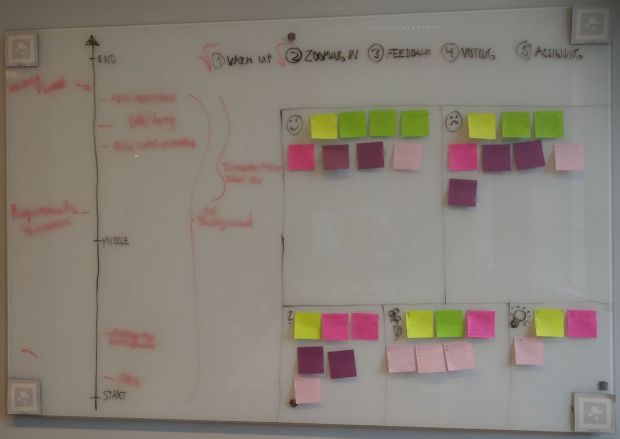n style=”font-weight:400;”>When a new member started in my team, he brought with him this interesting format for a retrospective. We have fine-tuned it together over a couple of iterations, and now there is time to write a blog post about it 🙂

Introduction
This format for retrospective have five steps to execute during the meeting:
- Warm up
- Zoom in
- Feedback
- Voting
- Discuss & Assign.
Below I will go through each and one of them, in some more detail.
Warm up
We always start with a short warm up exercise to “wake up our brains”. As a facilitator I will put out a statement, like the following, to the meeting participants:
- “Think one minute for a movie character that, for you, represent the last two weeks.”
- “Think one minute of a car manufacturer or car model that, for you, represent the last two weeks.”
After a minute or so I address each meeting participant individually, and they have to tell their choice + shortly motive it.
Zoom in
After we have gotten our brains going, we start to “zoom in” on the past time period that the retrospective shall cover. This we do using something we call “Pass the pen” (named as a homage to the good old “Pass the pennies”-game 🙂 )
Preparation: Draw a timeline, vertically (NOT horizontally!), on a whiteboard with three points: “Start”, “Middle” and “End” (see the picture above). The timeline is drawn vertically to make it easier for the meeting participants to write in events (from left to right) during this exercise.
Exercise: All team members are asked to stand in front of the whiteboard, with the timeline drawn onto it. A team member ask to “pass me the pen” and write one thing/event that did happen during the time period. When done, he or she holds up the pen in the air, and another person can ask “pass the pen” and so on. Let this go on for about 3-5 minutes, or events are stopped being added.
This exercise is used to, as a group, remember what did actually happen during the time period that the retrospective shall cover. It’s very easy to forget.
Feedback
This step is where most of the time shall be spent during the retrospective.
Preparation: The facilitator draws sections on the whiteboard (see the picture above) for the following five categories:
- 🙂 – Positive.
- 😦 – Negative.
- ? – Questions without a solution.
- <flower> – Positive words to share with a colleague, within, or outside of the team.
- <lightbulb> – Ideas/solutions.
Exercise: The meeting participants are asked to spend 10-15 minutes on writing post-it:s fitting the five categories presented above.
When everyone is done, one meeting participant at the time, steps up to the whiteboard and puts up their post-it:s + give a short verbal description for each one of them.
Note! Different colors on the post-it:s can be used to separate out each participant, if wanted/needed.
Voting
The retrospective now starts to come to an end, only two steps remain. In this step post-it:s from 😦 , ?, and <lightbulb> are grouped together on the whiteboard. The positive ones are of course great, and we shall be happy of them, but we don’t need to bring them further in the retrospective. For the <flowers>, those are collected by the facilitator and handed out to the ones that received them, after the meeting.
For the voting, the famous agile method of “dot voting” is used. Each participants gets three (or any other suitable number) “dots” to use how they want on the post-it:s.
To not bias each other (that much), all the participants gather in front of the whiteboard, with one pen each, and place their dots “at the same time” (after a “Ready, Set, Go”-call).
The (group of) post-it:s are now rearranged a bit again. Place the one(s) with most votes at the top, followed by the second most votes and so on.
Usually it’s quite easy to sort out the top 3-5 ones. The rest is abandoned, democracy have spoken and they have been decided “not important enough to take further at this point of time” (of course they can, and will, emerge again in a later retrospective).
Discuss & Assign
Time is soon up for the meeting, and the last thing we do is to discuss the top 3-5 activities/tasks that we select to take forward. This is done by discussing them to find concrete actions, and also to assign them to persons (that will own them).
Summary
What do you think about this format for a retrospective? To me it’s a nice mixture of “writing feedback on post-it:s” and Lean Coffee (democratically decide what is most important, in this case, to bring further). This retrospective can (and shall) be combined with an activity to follow up on actions from previous retrospectives. Best of luck with your next retrospective!
All the best,
Tomas from TheAgileist
Source link
